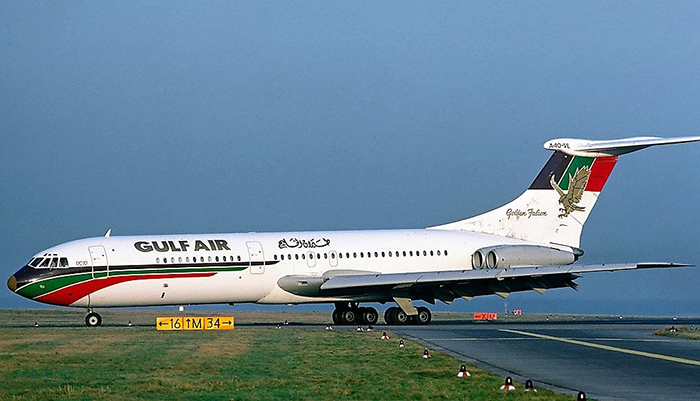

 TERRY SMITH looks back at this British Post-War Jetliner.
TERRY SMITH looks back at this British Post-War Jetliner.

As a child of the 50s, and becoming aware of things like major technology advancements in the 1960s, the Vickers VC10 summed up the period perfectly. It was a stunningly beautiful plane, with its swept back wings, rear mounted Conway engines, and high 'T' tail. It was the shot in the arm that the British commercial aircraft industry needed, after the setbacks of the Comet and the slightly backward step of producing the Turbo Prop Britannia. By the early 1960s, US companies like Boeing, with their 707, and Douglas with the DC8, were stamping their authority on the lucrative trans-Atlantic route, with even Convair briefly making a similar plane.
The Vickers Company, which later became part of BAC, was based in Weybridge, Surrey next to the Brooklands motor circuit. In the late 1950s they set about designing a large four-engined airliner, with the first prototype flying out of Weybridge in 1962. The initial order of 35 aircraft was from BOAC, who had already bought and was operating 15 Boeing 707s, but that plane did not fit in well with many of the British carriers’ routes which were going to much hotter destinations. Boeing's slightly underpowered engines did not perform well in the higher temperatures in many Commonwealth countries. The VC10, with its 4 powerful Conway jet engines, had no such trouble and handled these routes with ease, something that didn’t get missed by operators in other hot climates. VC10s ended up with Ghana Airways, Gulf Air, and East African as well as other operators, albeit in very small numbers.
This performance advantage over its US rivals meant that on the trans-Atlantic route the VC10 was faster and had the speed record for a non-supersonic airliner at 5 hours 1 minute, which it held for 41 years. The aircraft was loved by pilots and passengers who benefited from the rear mounted engines, making the cabin both quieter and smoother.
The earlier aircraft could take a maximum of 151 passengers, although in a two-class format which was the norm this dropped to 109. It was then joined by a slightly larger version, the 'Super' VC1, which had a 4m fuselage stretch increasing the overall capacity to 174 or to 139 passengers in two classes. There were even plans for a Super 200, which as its name implied would have taken 200 passengers, but it found no buyers. Other UK carriers such as British United Airways and British Caledonian operated the VC10, but due to larger aircraft becoming the norm on longer haul routes, sadly the aircraft never lived up to its sales potential. It enjoyed a reasonably long career lasting well into British Airways colours and the last commercial flight was in March 1981, however the VC10 story did not stop there.
Even at the time of its conception, the RAF was looking for a high-speed transport aircraft to not only move supplies and equipment, but to be able to deploy troops to anywhere in the world at short notice. A military version was planned almost from the beginning, with the RAF initially ordering 5 and a total of 14 by 1964. The aircraft had some changes over the civil version, such as a larger cargo door, extra fuel capacity, rearward facing seats and removable in-flight refuelling equipment. As more of the civil versions were retired, many of these were acquired by the RAF with some entering service or used as spares and repairs. In 1978, it was decided that some of the aircraft would be converted to replace the aging Victor tankers and BAE Systems, who were now responsible for the upkeep of the VC10, set about converting the aircraft for in-flight refuelling which was going to be much needed after the introduction of the Tornado in the early 1980s.
The tanker version was a huge success for the RAF and the plane, now known as the C1K ,continued in the role until 2013 when the last aircraft was put on display at Dunsfold - this is the large grey aircraft you can clearly see by the side of the Top Gear circuit. Many others survive today on static display, including one once owned by the Sultan of Oman which you can see and get inside at the Brooklands Museum. It was a beautiful aircraft that ended up serving the fare-paying public and its country very well indeed.

One of the first production aircraft leaving Weybridge in 1962.

The outline of the plane, the standard version is the side profile at the bottom.

While they had bought the 707 in the foreground, BOAC did commit to the VC10, which had a higher performance more suited to their routes.

The heart of this performance were these four rear-mounted Rolls Royce Conway engines.

While the skies were not awash with other operators, some other airlines from hotter climates also operated the aircraft.

New lease of life! A VC10 in RAF C1K configuration is seen refuelling two Typhoons, while a Tornado awaits his turn 'at the pumps'.

32 years after the last fare-paying passenger flew on one of these, the VC10 makes its final landing at Dunsfold in 2013, and as Clarkson would have said "...and on that bombshell..."